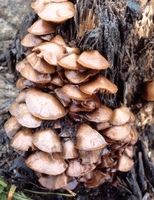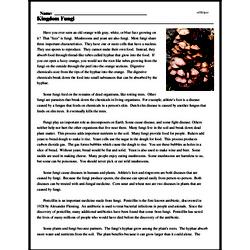Kingdom Fungi
Have you ever seen an old orange with gray, white, or blue fuzz growing on it? That "fuzz" is fungi. Mushrooms and yeast are also fungi. Most fungi share three important characteristics. They have one or more cells that have a nucleus. They use spores to reproduce. They cannot make their own food. Instead, they absorb food through thread-like tubes called hyphae that grow into the food. If you cut open a fuzzy orange, you would see the root-like tubes growing from the fungi on the outside through the peel into the orange sections. Digestive chemicals ooze from the tips of the hyphae into the orange. The digestive chemicals break down the food into small substances that can be absorbed by the hyphae.
Some fungi feed on the remains of dead organisms, like rotting trees. Other fungi are parasites that break down the chemicals in living organisms. For example, athlete's foot is a disease caused by a fungus that feeds on chemicals in a person's skin. Dutch elm disease is caused by another fungus that feeds on elm trees. It eventually kills the trees.
Fungi play an important role as decomposers on Earth. Some cause disease, and some fight disease. Others neither help nor hurt the other organisms that live near them. Many fungi live in the soil and break down dead plant matter. This process adds important nutrients to the soil. Many fungi provide food for people. Bakers add yeast to bread dough to make it rise. Yeast cells use the sugar in the dough for food. This process produces carbon dioxide gas. The gas forms bubbles which cause the dough to rise. You see these bubbles as holes in a slice of bread. Without yeast, bread would be flat and solid. Yeast is also used to make wine and beer. Some molds are used in making cheese. Many people enjoy eating mushrooms. Some mushrooms are harmless to us, but some can be poisonous. You should never pick or eat wild mushrooms.




